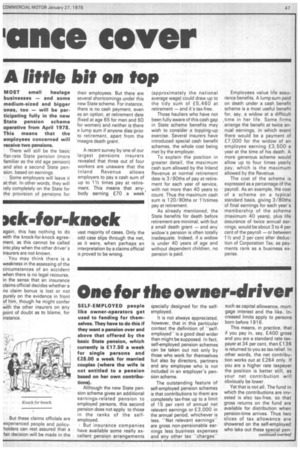A little bit on top
Page 49

If you've noticed an error in this article please click here to report it so we can fix it.
MOST small haulage businesses — and some medium-sized and bigger ones, too — will be participating fully in the new State pension scheme operative from April 1978. This means that the employees concerned will receive two pensions.
There will still be the basic flat-rate State pension (more familiar as the old age pension) and also a second State pension, based on earnings.
Some employers will leave it at that. In other words, they will rely completely on the State for the provision of pensions for their employees. But there are several shortcomings under this new State scheme. For instance, there is no cash payment, even as an option, at retirement date (fixed at age 65 for men and 60 for women) and neither is there a lump sum if anyone dies prior to retirement, apart from the meagre death grant.
A recent survey by one of our largest pensions insurers revealed that three out of four workers are unaware that the Inland Revenue allows employers to pay a cash sum of up to 11/2 times pay at retirement. This means that anybody earning £70 a week (approximately the national average wage) could draw up to the tidy sum of £5,460 at retirement — and it's tax-free.
Those hauliers who have not been fully aware of this cash gap in State scheme benefits may wish to consider a topping-up exercise. Several insurers have introduced special cash benefit schemes, the whole cost being met by the employer.
To explain the position in greater detail, the maximum cash sum allowed by the Inland Revenue at normal retirement date is 3 / 80ths of pay at retirement for each year of service, with not more than 40 years to count. Thus the maximum cash sum is 1 20/ 80ths or 1 1/2times pay at retirement.
As already mentioned, the State benefits for death before retirement are minimal, with but a small death grant — and any widow's pension is often totally inadequate. Indeed, if a widow is under 40 years of age and without dependent children, no pension is paid. Employees value life assurance benefits. A lump sum paid on death under a cash benefit scheme is a most useful benefit for, say, a widow at a difficult time in her life. Some firms arrange the benefit at twice annual earnings, in which event there would be a payment of £7,000 for the widow of an employee earning £3,500 a year at the time of his death. A more generous scheme would allow up to four times yearly pay, which is the maximum allowed by the Revenue.
The cost of the scheme is expressed as a percentage of the payroll. As an example, the cost of a scheme on a typical standard basis, giving 3/ 80ths of final earnings for each year's membership of the scheme (maximum 40 years), plus life assurance of twice annual earnings, would be about 3 to 4 per cent of the payroll — or between 11/2 and 2 per cent after deduction of Corporation Fax, as payments rank as a business expense.




















































































































